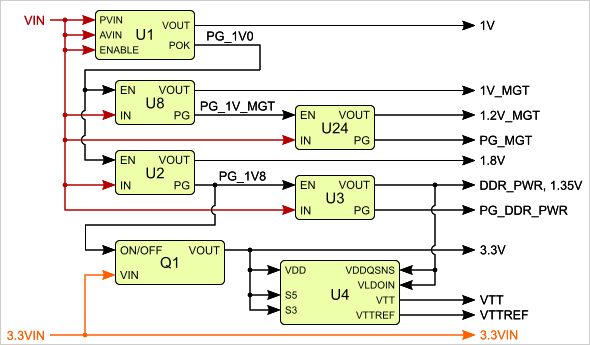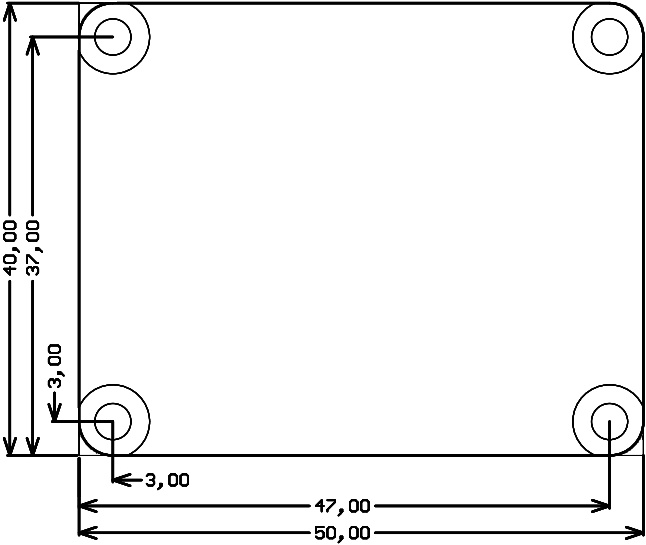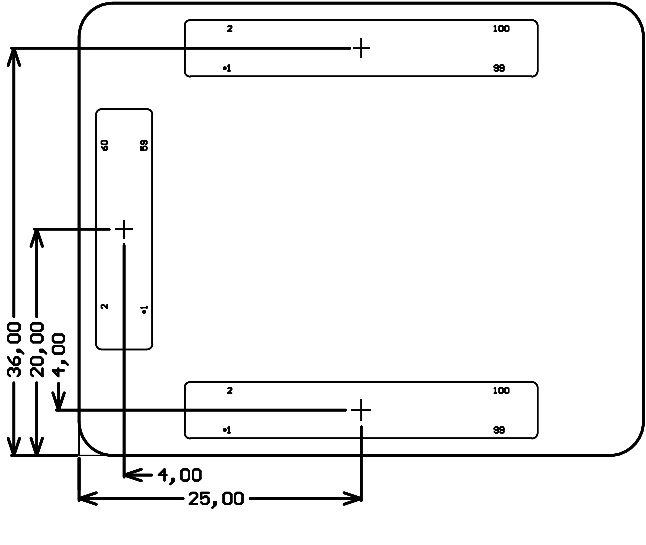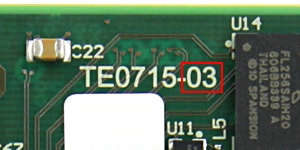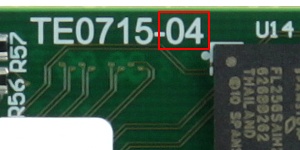Page History
...
| HTML |
|---|
<!-- Template Revision 1.64 (HTML comments will be not displayed in the document, no need to remove them. For Template/Skeleton changes, increase Template Revision number. So we can check faster, if the TRM style is up to date). --> |
| Scroll Ignore |
|---|
| Scroll pdf ignore | |
|---|---|
Table of Contents
|
Overview
| Scroll Only (inline) |
|---|
Refer to https://wiki.trenz-electronic.de/display/PD/TE0715+TRM for online version of this manual and the rest of available documentation. |
The Trenz Electronic TE0715 is an industrial-grade SoM (System on Module) based on Xilinx Zynq-7000 SoC (XC7Z015 or XC7Z030) with 1GByte of DDR3 SDRAM, 32MBytes of SPI Flash memory, Gigabit Ethernet PHY transceiver, a USB PHY transceiver and powerful switching-mode power supplies for all on-board voltages. A large number of configurable I/Os is provided via rugged high-speed stacking strips.
...
Industrial-grade Xilinx Zynq-7000 SoC (XC7Z015, XC7Z030)
- Rugged for shock and high vibration
- 2 × ARM Cortex-A9
- 10/100/1000 Mbps Ethernet transceiver PHY
- MAC address EEPROM
- 32-bit wide 1GB DDR3 SDRAM
- 32 MByte quad SPI Flash memory
- Programmable clock generator
- Transceiver clock (default 125 MHz)
- Plug-on module with 2 × 100-pin and 1 × 60-pin high-speed hermaphroditic strips
- 132 FPGA I/Os (65 LVDS pairs possible) and 14 PS MIO available on B2B connectors
- 4 GTP/GTX (high-performance transceiver) lanes
- GTP/GTX (high-performance transceiver) clock input
- USB 2.0 high-speed ULPI transceiver
- On-board high-efficiency DC-DC converters
- 4 A x 1.0 V power rail
- 3 A x 1.0 V power rail
- 3 A x 1.2 V power rail
- 3 5 A x 1.5 35 V power rail
- 1.5 3 A x 1.8 V power rail
- System management
- eFUSE bit-stream encryption
- AES bit-stream encryption
- Temperature compensated RTC (real-time clock)
- User LED
- Evenly-spread supply pins for good signal integrity
...
- 1. Xilinx Zynq-7000 all programmable SoC, U5
- 2. System Controller CPLD, U26
- 3. Programmable quad clock generator , U10
- 4. 10/100/1000 Mbps Ethernet PHY, U7
- 5. 2 x 4-Gbit DDR3L SDRAM (1.35 V), U12 and U13
- 6. Hi-speed USB 2.0 ULPI transceiver, U6
- 7a. B2B connector Samtec Razor Beam™ LSHM-150, JM1
- 7b. B2B connector Samtec Razor Beam™ LSHM-150, JM2
- 7c. B2B connector Samtec Razor Beam™ LSHM-130, JM3
- 8. 32-MByte quad SPI Flash memory, U14
- 9. Low-power RTC with battery backed SRAM, U16
- 10. 4A PowerSoC DC-DC converter, U1
- 11. Green LED (DONE), D2
- 12. Red LED (SC), D3
- 13. Green LED (MIO7), D4
- 14. 2-bit bidirectional 1-MHz I2C bus voltage-level translator, U20
...
| Bank | Type | B2B Connector | I/O Signal Count | Voltage | Notes | ||
|---|---|---|---|---|---|---|---|
13 | HR | JM1 | 48 | User | Supported voltages Allowed voltage level from 1.2V to 3.3V. | ||
34 | HR/HP | JM2 | 18 | User |
| ||
| 35 | HR/HP | 35 | HR/HP | JM2 | 50 | User | As above. |
34 | HR/HP | JM3 | 16 | User | As above. | ||
500 | MIO | JM1 | 8 | 3.3V | - | ||
501 | MIO | JM1 | 6 | 1.8V | - | ||
112 | GT | JM3 | 4 lanes | N/A - | See also next section MGT Lanes. | ||
112 | GT CLK | JM3 | 1 differential input | N/A | NB! AC coupling capacitors required on baseboard requiredcarrier board. |
Table 3: General overview of board to board I/O signals.
...
For detailed information about the pin-out, please refer to the Pin-out Table.
Scroll Pagebreak
MGT Lanes
MGT (Multi Gigabit Transceiver) lane consists of one transmit and one receive (TX/RX) differential pairs, two signals each or four signals total per one MGT lane. Following table lists lane number, MGT bank number, transceiver type, signal schematic name, board-to-board pin connector connection and FPGA pins Zynq SoC pin connection:
| Lane | Bank | Type | Signal Name | B2B PinFPGA | Zynq SoC Pin |
|---|---|---|---|---|---|
| 0 | 112 | GTX |
|
|
|
| 1 | 112 | GTX |
|
|
|
| 2 | 112 | GTX |
|
|
|
| 3 | 112 | GTX |
|
|
|
Table 4: MGT lanes overview.
Below are listed MGT banks bank reference clock sources.
| Clock signal | Bank | Source | FPGA Pin | Notes |
|---|---|---|---|---|
| MGT_CLK0_P | 112 | B2B, JM3-33 | MGTREFCLK0P_112, U9 | Supplied by the carrier board. |
| MGT_CLK0_N | 112 | B2B, JM3-31 | MGTREFCLK0N_112, V9 | Supplied by the carrier board. |
| MGT_CLK1_P | 112 | U10, CLK2A | MGTREFCLK1P_112, U5 | On-board Si5338A. |
| MGT_CLK1_N | 112 | U10, CLK2B | MGTREFCLK1N_112, V5 | On-board Si5338A. |
Table 5: MGT reference clock sources.
| Scroll Pagebreak |
|---|
JTAG Interface
JTAG access to the Xilinx Zynq -7000 SoC is provided through B2B connector JM2.
JTAG Signal | B2B Connector Pin |
|---|---|
| TMS | JM2-93 |
| TDI | JM2-95 |
| TDO | JM2-97 |
| TCK | JM2-99 |
Table 6: MGT lanes JTAG interface signals.
| Note |
|---|
| Note |
| JTAGEN pin in B2B connector JM1 should be kept low or grounded for normal operation. |
...
System Controller CPLD I/O Pins
...
Table 7: System Controller CPLD I/O pins.
| Scroll Pagebreak |
|---|
Quad SPI Interface
Quad SPI Flash (U14) is connected to the Zynq PS QSPI0 interface via PS MIO bank 500, pins MIO1 ... MIO6.
...
Table 8: Quad SPI interface signals and connections.page-break
SD Card Interface
SD Card interface is connected form the Zynq SoC's PS MIO bank 501 to the B2B connector JM1, signals MIO40 .. MIO45.
...
Table 9: Ethernet interface.
| Page break |
|---|
USB Interface
USB PHY is provided by USB3320 from Microchip. The ULPI interface is connected to the Zynq PS USB0. The I/O Voltage is fixed at 1.8V. The reference clock input of the PHY is supplied from an on-board 52.000000 MHz oscillator (U15).
...
On-board I2C devices are connected to the Zynq SoC's PS bank 501 MIO48 (SCL) and MIO49 (SDA) which are is configured as I2C1 by default. As bank 501 VCC_MIO1_501 is fixed to 1.8V, there is a bi-directional voltage-level translator used to connect 3.3V I2C addresses for on-board devices are listed in the table belowslave devices to the bus. Table below lists I2C slave device addresses and functions:
| I2C Device | IC | I2C Slave Address | Notes | ||
|---|---|---|---|---|---|
| 24AA025E48EEPROM | U19 | 0x50 | Serial EEPROMs with EUI-48™ node identity. | ||
| ISL12020M | U16 | RTC0x6F | Low-power RTC with battery backed SRAM. | ||
| ISL12020M | U16 | Battery backed RAM0x57 | Integrated Battery backed SRAM integrated into RTC. | ||
| SI5338A | U10PLL | 0x70 | Programmable quad clock generator. |
Table 11: Slave devices connected to the I2C interface.
On-board Peripherals
...
A Microchip 24AA025E48 EEPROM (U19) is used which contains a globally unique 48-bit node address , that is compatible with EUI-48TM specification. The device is organized as two blocks of 128 x 8-bit memory. One of the blocks stores the 48-bit node address and is write protected, the other block is available for application use. It is accessible through the I2C slave device address 0x50.
RTC - Real Time Clock
...
Table 12: Programmable clock generator I/Os.
Scroll Pagebreak
Oscillators
The module has following reference clock signals provided by on-board oscillators:
| Source | Signal | Frequency | Destination | Pin Name | Notes | |
|---|---|---|---|---|---|---|
| U18 | CLK | 25.000000 MHz | U10 | IN3 | ||
| U9 | CLK | 25.000000 MHz | U7 | XTAL_IN | ||
| U11 | PS-CLK | 33.333333 MHz | U5 | PS_CLK_500 | Zynq SoC PS subsystem main clock. | |
| U15 | CLK | 52.000000 MHz | U6 | REFCLK | USB3320C PHY reference clock. |
...
| Warning |
|---|
TE0715-xx-30 has several HP banks on B2B connectors. Those banks have maximum voltage tolerance of 1.8V. Please check special instructions for the baseboard to be used with TE0715-xx-30. |
Power
...
Consumption
Power supply with minimum current capability of 3A for system startup is recommended. Power ConsumptionMaximum power consumption of a module mainly depends on the design running on the FPGA. Xilinx provides power estimator excel sheets to calculate power consumption. It is also possible to evaluate the power consumption of the design with Vivado. See also Trenz Electronic Wiki FAQ.
| Power Input Pin | Typical Current |
|---|---|
| VINTBD* | To be determined. |
| 3.3VINTBD | *To be determined. |
Table 15: Power Typical power consumption.
* TBD - To Be Determined.
Power Distribution Dependencies
Figure 3: Module power distribution diagram.Lowest power consumption is achieved when powering the module from single 3.3V supply. When using split 3.3V/5V supplies the power consumption (and heat dissipation) will rise due to the DC-DC converter efficiency (it decreases when VIN/VOUT ratio rises). Typical module power consumption is between 2-3W.
Power-On Sequence
Figure 4: TE0820-02 power-on sequence diagram.
For For highest efficiency of the on-board DC/-DC regulators, it is recommended to use same 3.3V power source for both VIN and 3.3VIN power rails. Although VIN and 3.3VIN can be powered up in any order, it is recommended to power them up simultaneously.It is important that all baseboard I/Os are 3-stated at power-on until System Controller sets PGOOD signal high (B2B connector JM1, pin 30), or 3.3V is present on B2B connector JM2 pins 10 and 12, meaning that all on-module voltages have become stable and module is properly powered up
| Warning |
|---|
To avoid any damage to the module, check for stabilized on-board voltages should be carried out (3.3V (JM2-10, 12) or 1.8V(JM1-39) output) before powering up any FPGA's I/O bank voltages VCCO_x. All I/Os should be tri-stated during power-on sequence. |
See Xilinx datasheet DS187 (for XC7Z015) or DS191 (for XC7Z030) for additional information. User should also check related baseboard documentation when choosing baseboard design for TE0715 module.
...
B2B Name | B2B JM1 Pins | B2B JM2 Pins | Direction | Note |
|---|---|---|---|---|
| VIN | 1, 3, 5 | 2, 4, 6, 8 | Input | Supply voltage. |
| 3.3VIN | 13, 15 | - | Input | Supply voltage. |
| VCCIO13 | 9, 11 | - | Input | High range bank voltage. |
| VCCIO34 | - | 5 | Input | TE0715-xx-15: high range bank voltage. TE0715-xx-30: high performance bank voltage. |
| VCCIO35 | - | 7, 9 | Input | TE0715-xx-15: high range bank voltage. TE0715-xx-30: high performance bank voltage. |
| VBAT_IN | 79 | - | Input | RTC battery-buffer supply voltage. |
| 3.3V | - | 10, 12 | Output | Internal 3.3V voltage level. |
| 1.8V | 39 | - | Output | Internal 1.8V voltage level. |
| DDR_PWR | - | 19 | Output | Internal 1.5V or 1.35V voltage level, depends on revision. |
| VREF_JTAG | 91 | Output | JTAG reference voltage (3.3V). |
...
Board to Board Connectors
| Include Page | ||||||
|---|---|---|---|---|---|---|
|
Variants Currently in Production
...
Temperature
Range
...
B2B Connector
Height
...
| Trenz shop TE0715 overview page | |
|---|---|
| English page | German page |
Table 18: TE0715 variants currently in production.
Technical Specifications
Absolute Maximum Ratings
Parameter | Min | Max | Units | Notes |
|---|---|---|---|---|
VIN supply voltage | -0.3 | 6.0 | V | - |
3.3VIN supply voltage | -0.4 | 3.6 | V | - |
| VBAT supply voltage | -1 | 6.0 | V | - |
| PL IO bank supply voltage for HR I/O banks (VCCO) | -0.5 | 3.6 | V | - |
PL IO bank supply voltage for HP I/O banks (VCCO) | -0.5 | 2.0 | V | TE0715-xx-15 does not have HP banks. |
| I/O input voltage for HR I/O banks | -0.4 | VCCO + 0.55 | V | - |
| I/O input |
Table 18: TE0715 variants currently in production.
Technical Specifications
Absolute Maximum Ratings
Parameter | Min | Max | Units | Notes | ||||||||||
|---|---|---|---|---|---|---|---|---|---|---|---|---|---|---|
VIN supply voltage | -0.3 | 6.0 | V | - | ||||||||||
3.3VIN supply voltage | -0.4 | 3.6 | V | - | ||||||||||
| VBAT supply voltage | -1 | 6.0 | V | - | ||||||||||
| PL IO bank supply voltage for HR I/O banks (VCCO) | -0.5 | 3.6 | V | - | ||||||||||
| PL IO bank supply voltage for HP I/O banks (VCCO) | -0.555 | 2.0 | V | TE0715-xx-15 does not have HP banks. | I/O input voltage for HR I/O banks | -0.4 | VCCO + 0.VCCO + 0.55 | V | -I/O input voltage for HP I/O banks | -0.55 | VCCO + 0.55 | V | TE0715-xx-15 does not have HP banks. | |
| GT receiver (RXP/RXN) and transmitter (TXP/TXN) | -0.5 | 1.26 | V | - | ||||||||||
Voltage on module JTAG pins | -0.4 | VCCO_0 + 0.55 | V | VCCO_0 is 3.3V nominal. | ||||||||||
Storage temperature | -40 | +85 | °C | - | ||||||||||
| Storage temperature without the ISL12020MIRZ and 88E1512 | -55 | +100 | °C | - |
Table 19: TE0715 module absolute maximum ratings.
| Note |
|---|
| Assembly variants for higher storage temperature range are available on request. |
...
Recommended Operating Conditions
| Parameter | Min | Max | Units | Notes | Reference Document | ||
|---|---|---|---|---|---|---|---|
| VIN supply voltage | 2.5 | 5.5 | V | ||||
| 3.3VIN supply voltage | 3.135 | 3.465 | V | ||||
| VBAT_IN supply voltage | 2.7 | 5.5 | V | ||||
PL I/O bank supply voltage for HR I/O banks (VCCO) | 1.14 | 3.465 | V | Xilinx datasheet DS191 | |||
PL I/O bank supply voltage for HP I/O banks (VCCO) | 1.14 | 1.89 | V | TE0715-xx-15 does not have HP banks | Xilinx datasheet DS191 | ||
| I/O input voltage for HR I/O banks | (*) | (*) | V | (*) Check datasheet | Xilinx datasheet DS191 or DS187 | ||
| I/O input voltage for HP I/O banks | (*) | (*) | V | TE0715-xx-15 does not have HP banks (*) Check datasheet | Xilinx datasheet DS191 | ||
| Voltage on Module JTAG pins | 3.135 | 3.465 | V | VCCO_0 is 3.3 V nominal |
Table 20: TE0715 module recommended operating conditions.
...
All dimensions are given in millimeters.
Figure 35: TE0715 physical dimensions.
...
Hardware Revision History
| Date | Revision | Notes | Link to PCN | Documentation Link |
|---|---|---|---|---|
| 2022-12-21 | 05 | Third production release | TE0715-05 | |
| 2016-06-21 | 04 | Second production release | Click to see PCN | TE0715-04 |
| - | 03 | First production release |
| TE0715-03 | ||
| - | 02 | Prototypes |
| TE0715-02 | ||
| - | 01 | Prototypes |
Table 21: TE0715 module hardware revision history.
Hardware revision number is printed on the PCB board together with the module model number separated by the dash.
Figure 46: TE0715 hardware revision number.
Document Change History
Date | Revision | Contributors | Description | Contributors | Description | ||||||||||||||||||||||||
|---|---|---|---|---|---|---|---|---|---|---|---|---|---|---|---|---|---|---|---|---|---|---|---|---|---|---|---|---|---|
|
|
|
| ||||||||||||||||||||||||||
| 2021-06-21 | v.87 | John Hartfiel |
| ||||||||||||||||||||||||||
| 2018-07-06 | v.86 | John Hartfiel |
| ||||||||||||||||||||||||||
2017-11-14 | v.85 | John Hartfiel |
| ||||||||||||||||||||||||||
| 2017-09-10 | v.82| Page info | | modified-date | modified-date | dateFormat | yyyy-MM-ddJan Kumann |
| ||||||||||||||||||||||
| 2017-06-07 | v.64 | Jan Kumann |
| ||||||||||||||||||||||||||
| 2017-03-02 | v.59 | Thorsten Trenz |
| ||||||||||||||||||||||||||
| 2017-02-10 | v.58 | Thorsten Trenz |
| ||||||||||||||||||||||||||
| 2017-01-25 | v.55
| Jan Kumann |
| ||||||||||||||||||||||||||
| 2017-01-14 | v.50 | Jan Kumann |
| ||||||||||||||||||||||||||
| 2016-11-15 | v.45 | Thorsten Trenz |
| ||||||||||||||||||||||||||
| 2016-10-18 | v.40 | Ali Naseri |
| ||||||||||||||||||||||||||
| 2016-06-28 | v.38 | Thorsten Trenz, Emmanuel Vassilakis, Jan Kumann |
| ||||||||||||||||||||||||||
| 2016-04-27 | v.33 | Thorsten Trenz, Emmanuel Vassilakis |
| ||||||||||||||||||||||||||
| 2016-03-31 | v.10 | Philipp Bernhardt, Antti Lukats |
|
Table 22: Document change history.
...

